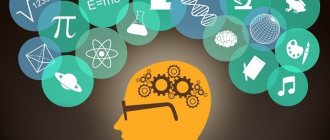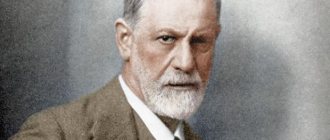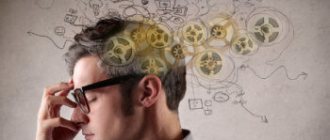The classification of types of memory is a complex system with many connections. Today, the most common approach to typifying memory is to identify the dependence of its characteristics on the specifics of the activity aimed at memorization and subsequent reproduction.
Memory is distinguished:
- according to the duration of data storage - long-term or short-term;
- by target activity – involuntary or voluntary;
- according to the characteristics of mental activity - figurative, emotional, motor (motor) and verbal-logical memory.
The largest group is represented by types of memory according to the characteristics of mental activity. All of them cannot fully exist and function separately from each other, since they interact very closely and the development of one is impossible without the progress of the other. However, the leading role is played by the verbal-logical branch, which, of all living organisms, is inherent only in humans. Many animals have motor, figurative and emotional memory in a primitive form, but only humans have verbal memory, and it must be developed intensively and systematically, starting from a fairly early childhood.
Games for the development of verbal and logical memory
Game No. 1. Prepare 10 pairs of words related in meaning. For example, an elephant is a trunk, a mouse is cheese, a cherry is a cherry, winter is a snowman, an iron is a shirt, a fork is a spoon, a glass is a drink, bread is a bun, light is a light bulb, fire is a spark.
Ask your child to listen carefully and remember a couple of words. Warn that you will say the first word, and he will say the second in each pair. When the child says he is ready (in about a minute), say the first words from the pair, keeping an interval between pairs (about 5 seconds).
Don’t be upset if you don’t succeed right away, treat this exercise as a game, and don’t forget to praise your child for the success achieved.
Game No. 2. Try the “reverse” exercise: “Logical chains.” To do this, prepare words that can somehow be grouped in pairs according to meaning. For example: apple - sea, cup - banana, anchor - pencil, chalk - saucer. Say that the “pairs” are mixed up, and now they need to be found and placed correctly. For example, an apple and a banana can be eaten, an anchor can be immersed in the sea, a cup and saucer can be used for drinking tea with chalk and a pencil.
Of course, such exercises require a little preparation, but as a result you will communicate with the child, play, and take another step in the development of verbal and logical memory. Engage with your child in such a way that he wants to communicate with you more.
Game No. 3 “Who’s the odd one out here?”
Prepare “threes” of words. In each of them, two should be combined in meaning, and one should “drop out”
Ask your child to find and remove this “extra” word from three words. For example:
- Pen, pencil, dog.
- Chair, flower, bed.
- Birch, chamomile, rose.
- Butterfly, mushroom, fly.
- Giraffe, hippopotamus, swan.
This way you can play with pictures too.
Game No. 4 “I’ll start, you continue!”
Ask your child to complete the sentences:
- Sasha didn’t eat the porridge because...
- Mom braided Natasha’s hair, and...
- Seryozha has run out of paint...
- We met in the forest...
Come up with several similar preparations in advance and have fun with your child!
Individual differences in memory in humans
Differences in memory can be explained by what type of memory is used most often. They are also influenced by the nature of the work performed and the characteristics of daily activities.
A striking example is researchers. They have developed semantic and logical types of memory, while the level of development of mechanical memory suffers.
All processes associated with memory, in particular the speed of memorization, as well as the speed of reproduction, which is important to understand, are influenced by personal characteristics, mood, interests and desires. The combination of these and other factors determines individual differences. They can also be explained by how emotionally significant this or that event is for a particular subject, what his state is at the moment of receiving the experience.
Some techniques that promote the development of verbal-logical memory
For babies:
- Learning poems and songs.
- Making up a story based on a picture.
- The same thing, but based on a series of pictures that logically form a story.
- Description story “What I saw on my walk today.”
- Retelling or discussion of a cartoon, or film, or book.
It is worth paying attention to the fact that adults, when communicating with a baby, should not distort or simplify words, “lisp.” Correct pronunciation by parents of all words also helps the child master verbal and logical memory.
For those who are older, no matter how old:
- Writing notes in the process of studying educational (and simply new, important) material.
- Emphasizing in notes and books (of course, only in personal ones) basic, key ideas.
- Retelling the content of an educational paragraph, or an educational article, or a film, or a book.
- Discuss what you read or watched.
- The most accurate retelling of news reports.
In addition, in our article Exercises to improve memory, you can read about exercises useful for memory development and about preparing for productive memorization. Also on our website there is a set of exercises for memory development.
Verbal-logical memory is associated with the left hemisphere of the brain, which is responsible for speech abilities, analysis, logic, detail, and abstraction. The left hemisphere ensures the construction of logical chains, the construction of reasoning, decision algorithms, and the logic of thinking. The right hemisphere, which is associated with intuition, creativity, and adaptation, provides a holistic perception of a complex and diverse world, i.e. is a necessary complement to the left.
To develop such important brain functions as memory, attention, thinking and perception, it is very convenient to use mental training on online brain game simulators.
We wish you success in self-development!
Basic theories of memory
A person and his brain are designed in such a way that some events leave an indelible mark, while others are quickly forgotten. Some of them take the form of stable constructs and, if necessary, are reproduced.
S. L. Rubinstein repeatedly noted in his works that without memory the existence of an individual and society as a whole would be impossible. As well as without understanding its essence and mechanisms.
The main psychological theories of memory are as follows:
- Association theory.
It is based on associations. The bottom line is that if certain formations arise and form in a person’s mind, associative connections are necessarily built between them. The repeated manifestation of any connection leads to the emergence of a general idea of all formations.
- Gestaltism.
Proponents of this theory believe that the basis for the formation of memory is the organization of knowledge and ideas according to the principle of isomorphism, that is, similarity in form. The implementation of memory functions is tied to the individual’s characteristic manners and behavioral characteristics.
- Activity theory.
Within the framework of this theory, memory is considered as a result of activity. Proponents of the concept consider all operations occurring in the brain in the context of the significance of a certain type of activity for the individual.
To remember or learn something, how do you usually do it?
Repetition is the mother of learning! I try to repeat and say it out loud or to myself more often
40%
I make various notes, write down what I need to remember.
0%
I have an excellent memory and I don’t need much effort to remember something.
0%
No matter what I do, nothing helps. I have a hard time learning anything
60%
There is no right answer
0%
Voted: 5
By duration of storage
The amount of stored information is always important for a person of any age. Why does someone remember facts from the most remote corners of childhood, while others cannot learn their own phone number? It turns out that the matter is not only in abilities, but also in what type of memory is developed in a person. After all, it also differs in the retention time of the material.
Depending on the duration of information retention, psychology distinguishes three types of memory.
Operational
Other names: working, intermediate.
Definition in psychology: when a person needs to isolate only the most relevant images and actions from instant perception.
Why is it needed: exclusively for performing specific actions that are necessary only at the moment. As soon as the goal is achieved, the information is immediately forgotten.
Examples: reading and cheating.
Development methods: perform exercises to train attention.
Controversial point. Psychologists argue whether RAM should be classified as a separate type. A number of experts believe that this is one of the subtypes of short-term. Others call it an intermediate link between short-term and long-term.
Short term
Other names: short-term, KVP.
Definition in psychology: short-term storage of information after a single short-term perception, when immediate reproduction is required.
Why is it needed: allows the mechanisms of experience accumulation to function fully. The volume and accuracy of long-term memory depends on it. If the information was poorly recorded in the KVP, it will transfer to the DVP deformed.
An example is everyday, routine work (washing dishes in a certain sequence, performing daily tasks according to a schedule), which must be done here and now.
Development methods:
- Use online brain trainers.
- Repeat the same material over and over again for a long time.
- Use the simplification method: break the material into meaningful blocks so that it is easier to remember.
- Master the association method.
- Use the emotional type of memory: to more clearly record an event, remember the feelings that it evokes in you.
Verbal and nonverbal memory
However, before we talk about how exactly this type of memory can be improved, it is necessary to fully understand what it is. And the easiest way to do this is through comparison - this way you can understand how verbal memory differs from nonverbal memory.
As mentioned earlier, in the first case, you remember information that comes to you from the outside in the form of text, words, speech. Accordingly, nonverbal memory is the exact opposite. And the information you receive and remember in this way is not text, speech, or anything else like that. Most often these are images, faces, images, aromas, sounds, etc.
Thus, verbal memory is responsible for verbal data, while non-verbal memory is responsible for figurative data. And at the same time, research shows that one type of memory is better developed in all people than the other. Why does this happen?
General classification
There are a large number of classifications of memory in domestic and foreign psychology. If you need to study this material in detail, you should look at the works of P. P. Blonsky, R. S. Nemov, F. N. Shemyakin, D. O. Hebb and other specialists.
There are only the main types; psychology identifies the following:
In fact, in addition to the main types of memory, descriptions of others can be found in the works of psychologists. For example, the classification according to the nature of mental activity sometimes also includes:
- sensory - visual, when fixation occurs at the moment of blinking;
- eidetic - combined, when visual impressions (which form its basis) are reinforced by others (auditory, gustatory, tactile), which allows subsequently to reproduce an unusually vivid image;
- social - preservation of socially significant information accumulated by previous generations;
- spatial - visual, allowing you to navigate the area well, remembering the features of the route.
The classification by duration is expanded by such a type as ultra-short-term memory (another name is the sensory register) - retaining information for several seconds. Includes iconic (for fixing visual material, lasts less than a second) and echoic (for acoustic, lasts 2 seconds).
Some psychologists classify types of memory into a separate group based on the type of organization of memorization:
- episodic - storage of specific information limited to a certain period (about a concert, for example);
- procedural (automatic) - a way of performing an action without taking into account its content, through skills brought to automaticity (driving skill).
Within each typology, several more species are distinguished. Psychologists are actively engaged in their classification to this day, constantly expanding and improving it.
Semantic memory
There is one more concept that is worth mentioning before moving directly to methods for developing and improving verbal memory. This is semantic memory. This concept is less common in everyday life, but it is used much more often in psychology. What it is?
Strictly speaking, this is a kind of system in which a person stores his generalized idea of the world around him in verbal form. Thus, this is a subtype of verbal memory, since semantic memory does not imply the storage of any emotions or experiences associated with information about the surrounding world. And these emotions can be stored exclusively in verbal format.










